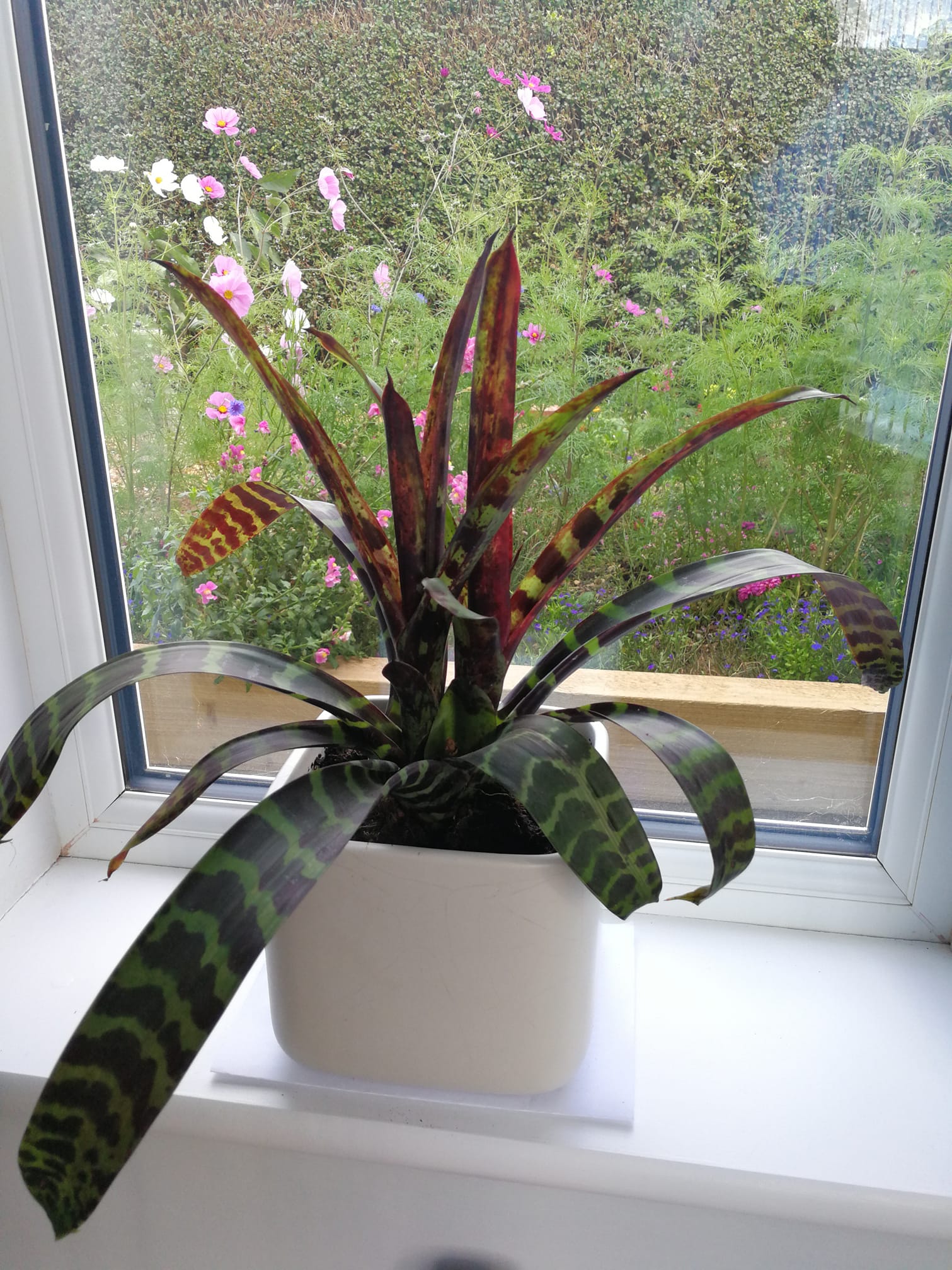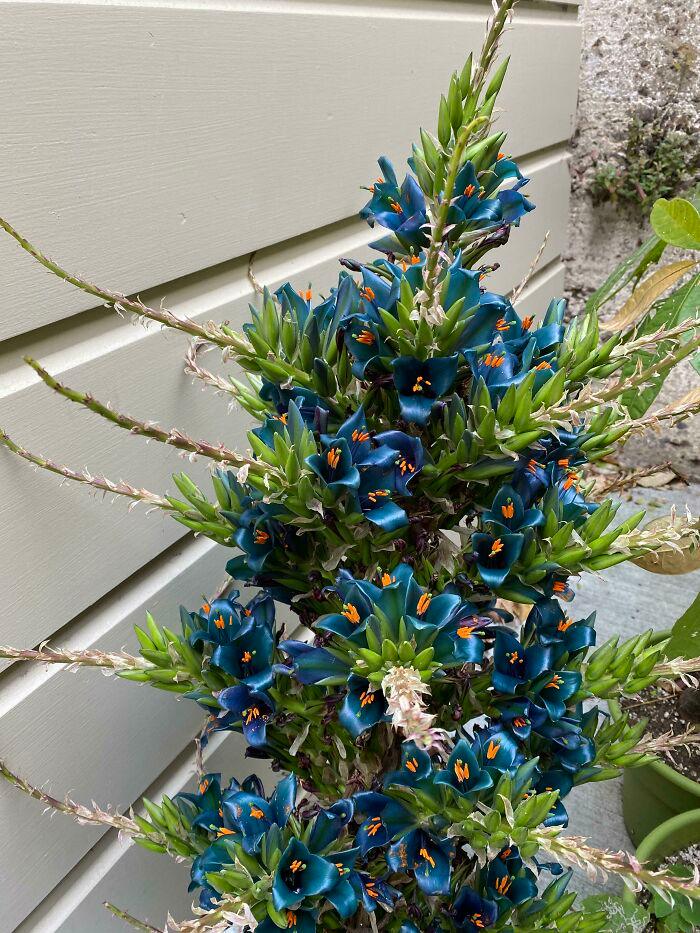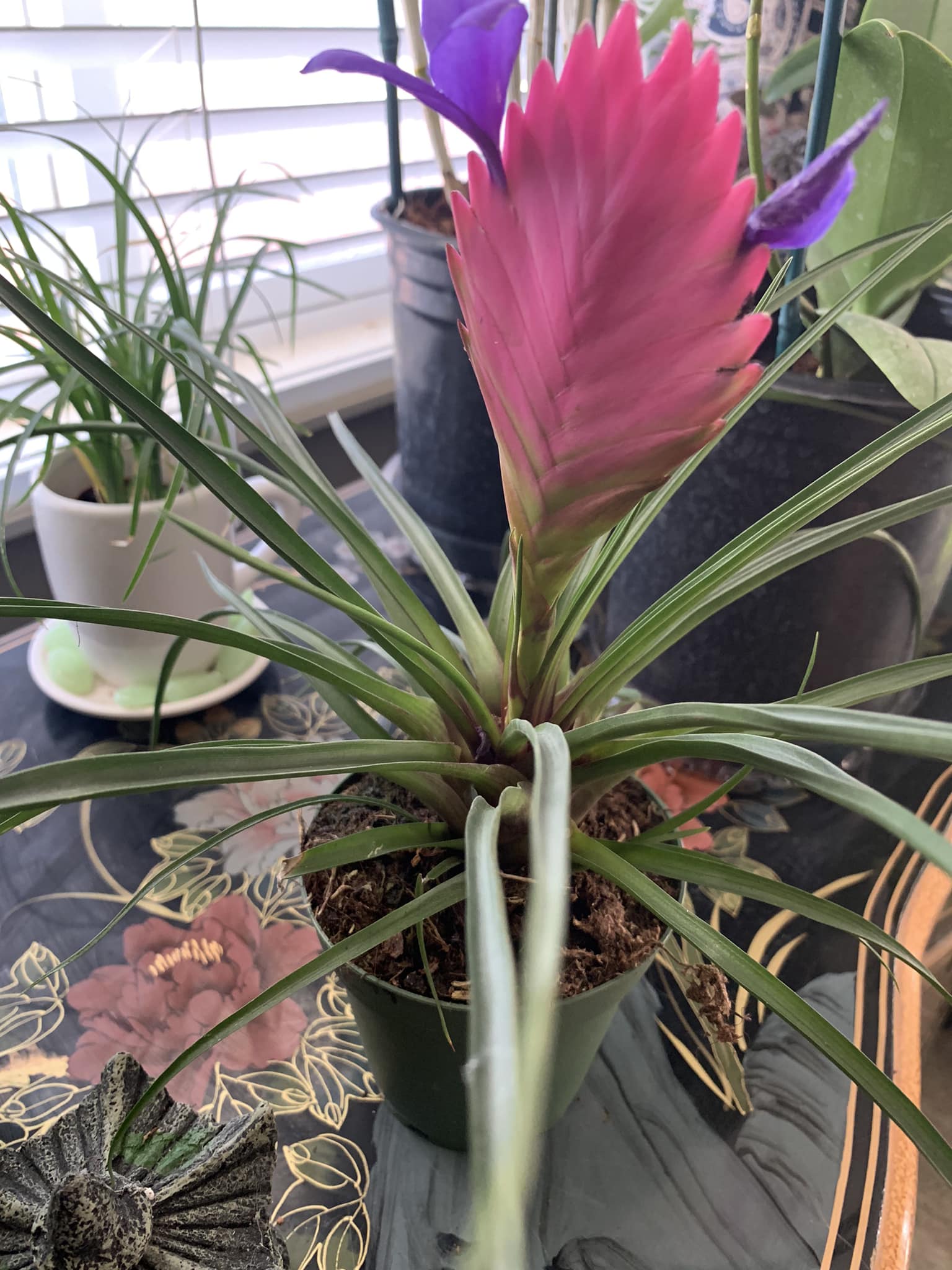Most Bromeliad varieties boast wide, sword-shaped or scoop-like leaves and develop around a central “cup,” which preserves water in the plant’s habitat.
Many other Bromeliads represent ornamental plants you can grow as gardens and houseplants. Here is the list you need to look forward to if you plan to get new ones.
Table of Contents Show
15 Bromeliad Varieties for Your Indoor Garden
Bromeliads are native mainly to the tropical Americas, with many species available in the American subtropics.
Let’s explore how many you can collect for your home decor or ornate your garden!
1. Portea Petropolilatana Bromeliad
Protea Petropolilatana is one of the Bromeliad varieties native to the eastern coast of Brazil. It has a rosette arrangement with a central cavity full of water.
To attract, Bromeliad leaves are linear, rigid, ascending reaching 1 m long and 4 cm wide with terminal thorn, which is bright yellow-green in the sun and deep, rich green in shades.

Also, the showy flowers usually bloom in late summer or fall, growing up to 70 cm, and last for a few months.
However, if planted indoors with the adequate sun in a south-facing window, it may bloom but be compact.
2. Pineapple Bromeliad
The Bromeliad family also consists of the pineapple plant or Ananas ananassoides, native to South America.
In addition, the foliage has waxy green leaves, linear, long-attenuate, acuminate, pungent leaves ranging from 90 to 240 cm in length and not over 25 mm in width above the dilated base.
Ananas ananassoides produce little enlarged globular to cylindrical fruit on a long and thin peduncle at the end of the flowering season in early summer. The fruit is about 10-15 cm long.
It is better to place them outdoors as it requires full sunlight, and the fruit may not form if planted indoors.
3. Quesnelia Arvensis Bromeliad
Quesnelia arvensis is native to southeastern Brazil and falls under the genus Quesnelia.
It grows on moss and organic debris in marshy woodland regions near the coast, where it is shaded, damp, and moist.
The plant boasts a cluster of leaves that forms a rosette that can grow up to 2 feet tall.
The leaves are dark green with a silver striping on the underside; the leaves contain prominent spines.
In addition, it has a white stem and a red flower with concealed blue petals, and the flower can grow 6-12 cm long and 4-6 cm in diameter.
4. Vriesea Splendens Bromeliad
Vriesea splendens, known as the flaming sword Bromeliad plant, is native to Trinidad, eastern Venezuela, and the Guianas.

As the name suggests, its flower is like a flaming sword that shoots in a long upright position.
Likewise, Vrieseas blooms in a simple, bright scarlet sword that can be up to 55 cm tall and 6 cm wide every three to five years, and the flowers last for months.
The plant grows in a rosette of short, stiff blue-green leaves with darker purple cross-bands on the underside. However, it can be non-toxic to pets, making them safe for your furry friends.
5. Neoregelia Medusa Bromeliad
Native to the South American rainforest, medusa Bromeliad can grow 9-12 inches tall and spread up to 4.5-7 inches wide.
Additionally, it does not do well during cold winter, so it is better to keep them indoors.
The foliage of Neoregelia is unique as it looks like someone has painted it with a color, making them perfect for adding contrast to your space.
Neoregelia carolinae produces about 20 cm tall and 35-60 cm across rosettes and features arrow, ribbon-like, leathery leaves measuring up to 40 cm long and 2.5-3.5 cm wide.
Like the other Bromeliads, this Neoregelia species produces only 4 inches of flowers and blooms for 8 to 10 weeks.
6. Aechmea Fasciata Bromeliad
Aechmea fasciata Bromeliad, also known as Silver Vase or Urn plant, is one of the most beautiful varieties of Bromeliad, in my opinion.
The specialty of Aechmea fasciata Bromeliad is the gorgeous pink flower and its green leaves with silvery horizontal banding.
Its pink flower rises out of the center of the bract, is 20-40 cm long, and can last up to six months.
Flowers produce small globular berries covered by a white tomentum-bearing fusiform seed, about 2 mm long.
7. Sapphire Tower Bromeliad
Sapphire tower Bromeliad, commonly known as Puya alpestris, is a Bromeliad variety native to the Chilean Andes and Argentina.
It is popular among the Bromeliad varieties for its exotic teal-colored flowers produced on tall inflorescence.

Mainly these Bromeliads are outdoor plants that can grow 3 to 4 feet tall with light green re-curving leaves with silver-gray undersides.
Similarly, the Sapphire tower produces turquoise blue-green flowers with vivid orange stamens held on branching, up to 4 feet (1.2 m) tall stalks.
These flowers usually appear in spring, but not every year, blooming for the first time in 5 to 6 years.
8. Hechtia Argentea Bromeliad
Hechtia argentea Bromeliad is another variety native to Mexico known by its common name, “Silver Star.”
It was discovered in a Mexican canyon for the first time in 1860, and that particular plant lived for more than 150 years.
The plant’s several long and re-curving green leaves are coated with white scales, giving the plant a silvery look.
Likewise, the long inflorescence bears clusters of white flowers on short spikes.
Hechtia argentea also produces a wide, symmetrical rosette that spreads beautifully and makes a tall spike of orange flowers.
9. Guzmania Bromeliad
Guzmania Bromeliad is another variety native to subtropical North America, Central America, and South America and found at altitudes of up to 11,483 ft.
They are ideal in the bedroom or living room due to their striking flowers and can thrive best outdoors under the canopy of trees.
The plant dies after it has produced its flowers in summer, but new plants can easily be propagated from the offsets, which appear as the parent plant dies.
Likewise, the foliage is green, standing upright, and can reach 48 inches tall and 36 inches wide if planted outdoors.
Guzmania wittmackii features unarmed, glossy dark green leaves ranging from 60 to 80 cm long and 2-3 cm broad and about 80 cm long inflorescence, and the flowers inside the bracts are white with about 9 cm long petals.
The following species of Guzmania have been placed on the International Union for Conservation of Nature (IUCN) Red List of threatened species:
- Guzmania osyana
- Guzmania zakii
- Guzmania albescens
- Guzmania henniae
- Guzmania izkoi
- Guzmania bismarcki
10. Cryptanthus Bivittatus Bromeliad
Native to Brazil, Cryptanthus Bromeliad is also known as the Starfish plant, Earth Star, or Red Star Bromeliad.
These plants can have ten to twenty leaves with small teeth or thorns on their wavy borders.
In addition, strips on the plants can be in ivory tones and different colors of red and pink making it a popular houseplant.
These plants may grow up to two feet across despite their flat appearance. Also, they produce tubular white and usually remain partially hidden in the middle of the rosette.
11. Tillandsia Cyanea Bromeliad
Tillandsia cyanea Bromeliad, also known as the Pink quill, fan flower, and blue-flowered torch, is native to the rainforest of Ecuador.
Being a small variety of Bromeliads, it blooms an exotic pink-flowering bract which is the main attraction of this plant.
The flowers with three petals are pansy-shaped, reach 20 cm in height and have a cinnamon fragrance in the morning.

The flower is purple, in tone color between pink-violet to dark blue, and each flower lasts 1-3 days, and the plant continues to bloom for 1-3 months.
After flowering, the plant’s lifespan decreases, but by making it flower and bearing the seeds, you can save the generation of the plant.
12. Queens Tears Bromeliad
Queen’s tears, friendship plant, or Billbergia nutans, is an epiphytic Bromeliad native to Brazil, Paraguay, Uruguay, and Argentina.
It is an ornamental plant due to its unique flowering structure, which blooms in upright clumps of a trumpet shape. And this Bromeliad variety can grow around 24 inches tall.
This rainbow-colored tropical plant also produces upright clumps of trumpet-shaped and grayish-green leaves.
Besides, its arching stems have pink bracts and lime-green petals rimmed in royal blue, and each long-lasting flower displays a long yellow stamen.
These flowers bloom several times yearly, usually lasting 6 to 8 weeks.
13. Alcantarea Imperialis Bromeliad
Alcantarea imperialis is one of the large Bromeliad varieties that originated from the mountain range in Brazil.
It boasts large leaves that are leathery and can grow up to 5 feet in length and 6 inches in width.
The plant blooms early to mid-spring over a 5-month flowering period.
In addition, the towering spike grows up to 400-600 tiny white flowers over six months, producing abundant food for insects and nectar-feeding birds.
Also, the broad strap leaves form rosettes and range in color from flushing green to wine-red.
14. Dyckia Brevifolia Bromeliad
Native to Brazil, Dyckia brevifolia Bromeliad is also known as Sawblade or Pineapple dyckia.
It forms rosettes of short, stiff green leaves that flush golden yellow near the plant’s top with sharp spines that can grow up to 8 inches.

However, they are not succulents as they do not store water in their leaves.
The plant has a nearly stalkless cluster about 45 cm (17 inches) high, which rises from the rosette.
Also, Dyckia brevifolia produces small spikes of beautiful yellow flowers in summer, and its flower stalk rises about 30 cm (12 inches), bearing 30 to 40 yellow blossoms.
15. Blue Tango Bromeliad
Blue tango or Yunakesa aechmea is another popular Bromeliad variety, a hybrid from Bullis Bromeliads that originated in Florida.
The plant’s main attraction is its leaves, which are long, smooth, simple, green, and arranged around a central point in a rosette.
The average number of leaves per plant ranges from 12 to 15 and measures 64 cm. Nonetheless, the electric blue flowers add more ornamental statements to the place.
Their flowers grow in showy clusters of hot pink, purple, and blue bracts, which emerge on a stem from the center of the plant.
Some More Varieties of Bromeliad
| Bromeliad Varieties | Maximum Growth Size | Features |
|---|---|---|
| Billbergia Pyramidlis Bromeliad | Length: 10-30 cm Spread: 30-50 cm | Blooms large red brush shaped flower tipped with violet Surrounded by a rosette of strap-like leaves |
| Neoregelia blast | Length: 15-20 cm Width: 20-30 cm | Green leaves with thick white stripes on the perimeter and few white lines as well |
| Nudularium Fulgens Orange | Length: 25-30 cm Spread: | Long dark green leaves with orange flower emerging in the center |
| Billbergia euphemiae var. purpurea | Length: 40 cm Spread: 30 cm | Light green leaves which are hardy with burgundy undersides |
| Neoregelia avodon | Length: 20 cm Sperad: 30 cm | Slender green leaves with white stripes on the perimeter |
| Billbergia caramba | Length: 30-40 cm Spread: 20 cm | Long slender green leaves with white spots and burgundy underside |
| Nidularium rocerum ruba | Length: 30-40 cm Width: 40-45 cm | Green hardy leaves where red blossom emerges from the centers |
| Quesnelia Farro | Length: 2- 3 feet Spead: 1.5 feet | Long yellowish-green leaves with yellow band on the perimeter |
| Neoregelia aztec | Length: 25-30 cm Width: 30-40 cm | Olive green leaves with red spots throughout |
| Vriesiea fosteriana | Length: 3.2 feet Width: 3-4 feet | Rosettes of wide green leaves with smooth edges and a prominent black banding |
Proven Tips to Care For Bromeliad Plants
Bromeliads are air plants, so you need not be bound to strict schedules when growing these species.
Below are some of the tips that are essential for your Bromeliad varieties to thrive.
- You can place the plant in bright indirect light for at least 5 to 7 hours, and in low light conditions, you can insert grow lights.
- Maintain humidity above 60% relative humidity. If you have dry air at home, increase the humidity by misting the plant periodically.
- You can also use a mixture of perlite, peat moss, and pine bark to make the best soil for your Bromeliad. Consider the soil pH ranging from 5.0 to 6.0.
- Catering every 3-4 months during the growing season with general-purpose 20-20-20 fertilizer will be enough.
- Maintain the temperature between 70 and 90°F as it likes warmer temperatures.
- It would be best to water them when the top inches are dry, i.e., once a week.
- Mealybugs are the most common Bromeliad pests; you need rubbing alcohol to eliminate them.
Editor’s Note
The Bromeliad varieties can make your entire house and garden a natural paradise with their multicolored leaves and towering flowers.
Besides ornamental convenience, Bromeliads also purify the air and relax the nerves, leveraging your gardener’s lifestyle.
Good luck!



2 comments
Thank you for the detailed explanations and great pictures. Bromeliads do make your garden look like a tropical paradise!
I am glad I could help. Can you tell me which Bromeliad/s you chose for your home?
You can also check out other articles which will guide you on how to take care of Bromeliads, the problems they may encounter, and their solutions.